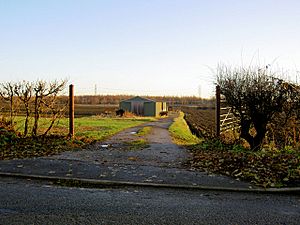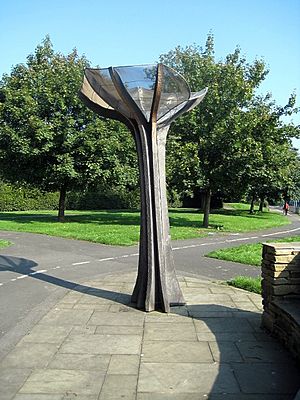Rhubarb Triangle facts for kids
The Rhubarb Triangle is a special area in West Yorkshire, England. It's about 9 square miles (23 square kilometers) and is located between the towns of Wakefield, Morley, and Rothwell. This area is famous for growing a special type of rhubarb very early in the year.
The Rhubarb Triangle used to be much larger, covering an area between Leeds, Bradford, and Wakefield. From the early 1900s to the 1930s, the rhubarb farming grew a lot. At its busiest, it covered about 30 square miles (78 square kilometers)!
Rhubarb originally comes from Siberia. It grows really well in the cold, wet winters of Yorkshire. In the past, West Yorkshire produced 90% of the world's winter forced rhubarb. This rhubarb was grown in special warm, dark buildings called forcing sheds, which were common across the fields.
In February 2010, the "Yorkshire Forced Rhubarb" was given a special status called Protected Designation of Origin (PDO). This means its name is legally protected by the European Commission, similar to how Champagne or Stilton cheese are protected. This status was recommended by the Department for Environment, Food and Rural Affairs (Defra), which is a government department in charge of food and the environment.
Contents
How Rhubarb is Grown
The way forced rhubarb is grown was first developed in the early 1800s. Farmers would make the fields rich with lots of natural fertilizers, like horse manure and waste from nearby towns and wool factories.
The rhubarb plants stay in the fields for two years without being picked. During this time, they store energy from the sun in their roots as carbohydrates. Then, in November, the roots are exposed to frost before being moved into warm sheds. These sheds are kept completely dark.
Inside the warm, dark sheds, the plants start to grow quickly. The stored carbohydrates in their roots turn into glucose. This process gives forced rhubarb its unique sour-sweet taste. The sheds are long, low buildings that are heated. They used to be heated with coal, which was cheap and easy to find in the area. Now, they are usually heated with diesel.
Forced rhubarb grown in these sheds is much softer and more tender than rhubarb grown outdoors in the summer. Because there is no daylight, the rhubarb leaves are a yellow-green color. The stalks are a beautiful crimson (dark red) color and feel very smooth. They usually grow to be about 2 feet (60 centimeters) long. Traditionally, the people who pick the rhubarb use candlelight. This is because any bright light would stop the rhubarb from growing. By the end of March, the harvest is finished. The roots are completely used up and are then turned into compost.
History of Rhubarb Farming
Many hundreds of small farmers and gardeners originally grew and forced rhubarb. Over time, some growers became larger, owning many thousands of rhubarb roots and lots of forcing sheds. In the late 1800s, early forced rhubarb was sent to big markets in London, like Spitalfields and Covent Garden, just in time for Christmas. It was even sent to Paris for the French market!
A special express train, run by the Great Northern Railway Company, carried rhubarb every weekday night during the forced rhubarb season. This season lasted from Christmas until Easter. The train left from Ardsley station. Before 1939, at the busiest time, up to 200 tons of rhubarb were sent daily by as many as 200 growers. In 1962, a train strike made growers find other ways to transport their rhubarb, and the train service stopped soon after. You can see a permanent display about forced rhubarb at the Wakefield Museum. After the Second World War, rhubarb became less popular as more exciting fruits became available.
The name "rhubarb triangle" was first used in a textbook in 1965. This book mentioned special pre-war trains called "rhubarb specials" that ran from the West Riding rhubarb triangle to London. The name was also mentioned in the Guardian newspaper in 1986.
Special Recognition for Yorkshire Forced Rhubarb
Twelve farmers who grow rhubarb in the Rhubarb Triangle asked for "Yorkshire forced rhubarb" to be added to a special list. This list is part of the European Commission's Protected Food Name scheme, which legally protects the names of certain foods and drinks. Their application was successful! The farmers in the Rhubarb Triangle were given Protected Designation of Origin (PDO) status in February 2010.
This protected status helps farmers in a few ways. It can give them European funding to promote their product. It also provides legal protection, meaning other products made outside the Rhubarb Triangle cannot use the name "Yorkshire forced rhubarb." Other famous protected names include Stilton cheese, Champagne, and Parma Ham. Hilary Benn, a politician who was the Member of Parliament for Leeds Central, helped with the government's campaign to win this protected status.
Rhubarb Culture
Wakefield Council holds an annual Rhubarb Festival every February. This festival celebrates the area's history with rhubarb and helps promote the rhubarb industry that still exists today. The festival includes a Farmers' Market, cooking demonstrations, walks, and tours of the rhubarb forcing sheds.
In 2005, Wakefield Council put up a sculpture of a rhubarb plant in Holmfield Park in Wakefield. Rhubarb growing and the "Rhubarb Express" train are also featured in the Wakefield Museum.




